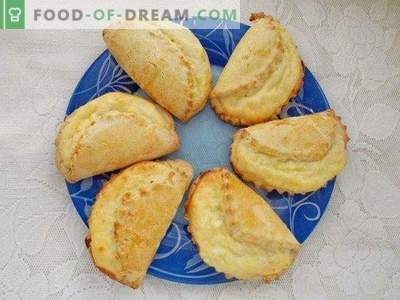This autumn red-haired beauty fully justifies its sunny appearance in terms of its nutritional and healing properties. Pumpkin is a truly universal product for cooks. From it you can cook soups, second courses, hot snacks, desserts and drinks! What is useful and how to properly store a pumpkin so that it does not lose its properties for as long as possible, read below.
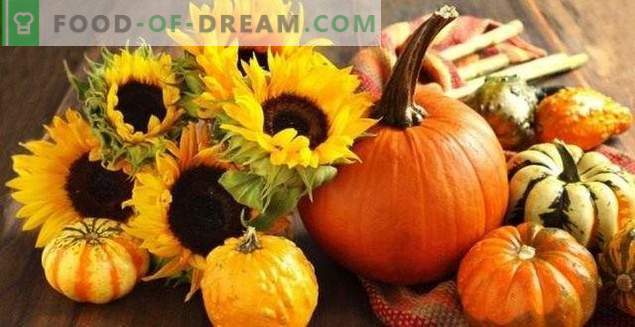
Orange is not the only pumpkin color. There are also red, blue, green, cream and white colors! By the way, the tradition to use a pumpkin as a symbol of Halloween is associated with the Irish legend. She says that one man named Jack, in anticipation of the Doomsday, wandered around the Earth, lighting his way with a piece of coal hidden from the rain in a pumpkin. More pumpkin more than once hit the Guinness Book of Records. For example, they recorded the largest weight of a pumpkin - 513 kg, which was grown by Jerry Chekton from Pennsylvania.
Content:
- Useful properties of a pumpkin
- Popular pumpkin table varieties
- Decorative Pumpkin
- Recipe - candied pumpkin
- How to store a pumpkin correctly
Useful properties of pumpkin
If we talk about the usefulness of pumpkin, then along with the standard set of vitamins A, E, C, B1, B2, B5, B6, PP it contains two valuable and rarely found vitamins, such as T and K. Our body needs vitamin to regulate the proper metabolism, and vitamin K - for good blood clotting. In some varieties of pumpkin Karotin more than five times in carrots, so it is especially useful for the prevention of vision problems. And still the pumpkin for 90% consists of water, it is low-calorie and rich in fiber. Pumpkin seeds contain cucurbitin, which deals a serious blow to the parasites in our body. And they also contain this amount of protein, which is comparable to its content in meat. By the way, pumpkin flowers are also eaten. This is especially practiced in Italy: pumpkin flowers fried in dough are considered a familiar dish.
As part of the pumpkin there are two valuable and rare vitamins, such as T and K. Vitamin T is necessary for our body to regulate the proper metabolism, and vitamin K - for good blood clotting
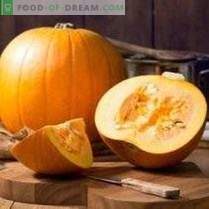

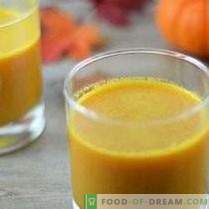
Popular table pumpkin varieties
There are about 20 types of pumpkin, differing from each other in color, shape of the fruit, size. There are decorative pumpkins, feed and dining. Varieties are divided according to the species: large-fruited, hard-skinned and nutmeg squash.
Pumpkin “Spaghetti”
This is probably the earliest variety. The fruit reaches 1 kg, when ripe it has a light green color, and when ripe it is cream. The pulp of Spaghetti beige shade, has a characteristic vanilla flavor. The peculiarity of this pumpkin is that after boiling it, the pulp as if breaks down into separate fibers, which makes them look like spaghetti.
Pumpkin “Premiere”
The fruits of this pumpkin variety can reach 6 kg. The skin at the Premiere is thick, has a green color with light green spots. The flesh of this variety is yellow, sweet and juicy. The value of the Premiere is that it is early ripe, resistant to low temperatures, has a high yield.
Pumpkin “Aport”
It has a rounded shape. Color - orange-yellow without a picture. Reaches 7 kg at the end of ripening. This sort of pumpkin is late ripening, the taste is juicy and sweetish-creamy. Suitable for those gardeners who seek a compact fit, since the Aport has a small bush and a short whip.

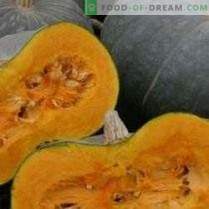
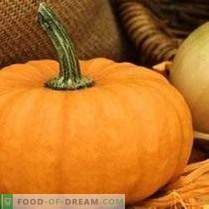
Pumpkin “Arabatskaya”
A common variety of nutmeg. This mid-late pumpkin has an elongated cylindrical shape that thickens towards the top. The average weight of this variety is about 7 kg. The skin of the Arabat pumpkin is thin and fragile, has an orange-yellow color. The flesh, on the contrary, is thick and dense enough, its taste qualities are juicy and sweet.
Pumpkin “Giant”
The name speaks for itself - it's a giant pumpkin. It is not surprising, because the fruits of the giant reach 180 kg. Coloring may be yellow or bright orange. Caring for this variety is quite laborious, because the size of the fetus needs careful attention. But the taste of the Giant deserves such care, because it is sweet even raw.
Decorative Pumpkin
I must say a few words about the decorative pumpkins, which are not eaten, but they find their successful use in everyday life.
Lagenarius. This sort of pumpkin got its popularity not for its nutritional properties, but for the opportunity to use its ripe fruits as dishes. After six months of storage, it completely loses moisture, the crust becomes ligneous, and the pumpkin is ready for making all kinds of handicrafts. The shape of the fruit is so diverse that it allows you to make dishes for all occasions: bottles, jugs, flasks with a narrow neck, balls and ovals for plates.
Pumpkin dishes are light, strong and durable. And in Latin America they make vessels for mate from it - Calebasas and musical instruments - maracas and rattles. Peruvian Indians not only loved to eat a pumpkin, but also used it as a trough for bathing children in it, and also dried their flesh and woven mats out of it. Pumpkin was one of the first vegetables, contributing to the emergence of the art of cutting patterns on vegetables and fruits - carving. Vases were obtained from it, for which they were grown in special forms. And in China, pumpkin lanterns were very popular, which are still a success.
If you want to grow decorative pumpkins in your garden, remember that they should be planted away from edible varieties. The substances contained in these types, called cucurbitacins, are poisonous and bitter in taste. A planted ornamental gourd next to an edible can pereopylitsya with it, thereby adding a “drop of bitter” to the table pumpkin variety.
If you want to grow decorative pumpkins in your garden, remember that they should be planted away from edible varieties.
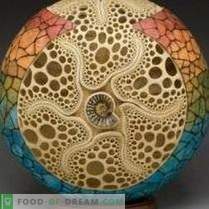

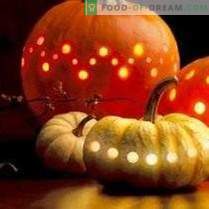
Recipe - candied pumpkin
Pumpkin candied fruits are much more useful than sweets, although they are not inferior in taste to anything.
Ingredients for Pumpkin Candies
- 1 kg of pumpkin;
- 5 g of citric acid;
- 800 g of sugar;
- cinnamon.
A method of cooking candied pumpkin
- My pumpkin, remove the peel and seeds. We cut into cubes about 2x2x2 cm. We pour 200 g of sugar on them and keep them in the cold until the pumpkin lets out juice.
- Put the pumpkin on the fire and boil, stirring constantly. Cool, drain juice. Pour one glass of juice to the remaining sugar, add citric acid and cook to dissolve the sugar. This syrup is poured into the pumpkin, put on a slow fire and cook until the pumpkin becomes transparent and the syrup is thick.
- We get pumpkin, dry it, sprinkle with cinnamon, powdered sugar or zest. Fold in a box and store at room temperature.
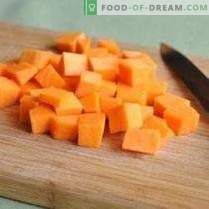
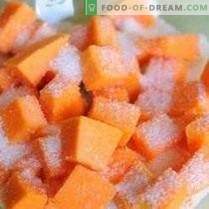

See also a detailed recipe for candied pumpkin.
How to store a pumpkin correctly
You have harvested, and now you face the task: to keep the pumpkin safe and sound, so that it does not rot and dry, and also retains all the beneficial properties as long as possible. In fact, the secrets of its storage are very simple, because this fruit, due to its thick peel, has the properties to retain useful and taste qualities for a long time.
A distinctive feature of the pumpkin from other melon crops is that the maximum amount of nutrients accumulates in the pumpkin after it is brought from the garden, and it will lie for another 35-40 days. After harvesting, the pumpkin contains an enormous amount of starch, which hydrolyzes after storage, which leads to an increase in the amount of sugar, and the fruits become sweeter. So have patience for a couple of months, forgetting about the pumpkin. Let yourself taste better!
Five Important Pumpkin Storage Rules
1. Pumpkin can ripen perfectly in the apartment, unlike watermelons. For example, under the bed, where important factors are stored for storing pumpkins - darkness and dryness, as well as a warmed balcony. However, be careful: in order to avoid light falling on the pumpkin, cover it with any cloth.
2. Pumpkin can be stored in a room at a temperature of +8 .. + 12 degrees, which can significantly extend its preservation to one and a half years.
3. Make sure that the pumpkin stem is not damaged, respectively, before storage, the tail-stalk should not be cut to prevent rotting of the fruit. 4. Lay the pumpkin with the stalks up and try to keep the fruits from touching each other.
5. If you find rotten parts on the pumpkin, remove the pulp as soon as possible. After processing cut using a candle flame or a lighter: so you disinfect and dry the damaged place. But remember that after this procedure, the pumpkin will lie no more than two weeks.
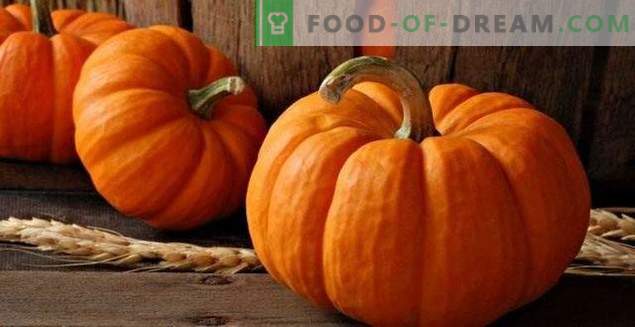
Came to us from the West and beloved bright Halloween holiday gave the pumpkin another appointment, making it a subject for creativity in the autumn evenings.
However, do not forget the original and basic value of the pumpkin, revered by our people from ancient times. Pumpkin, first of all, a symbol of longevity, family happiness and prosperity. It was not for nothing that it was believed that if there was a pumpkin crop in the house, then hunger for those living in it is not terrible. Read the traditions of our ancestors, use the gifts of our land with due respect and good health you will not hold.
Source - Blog GreenMarket


